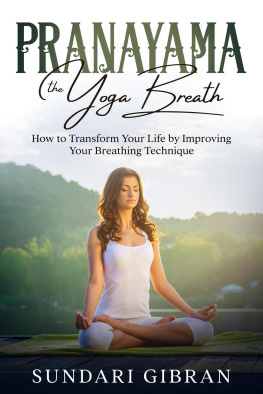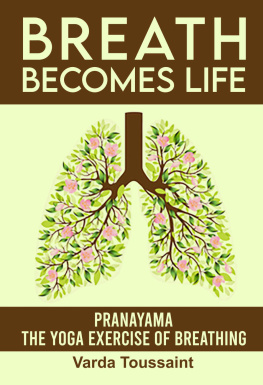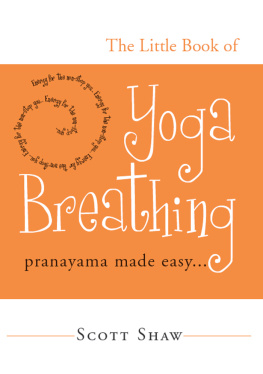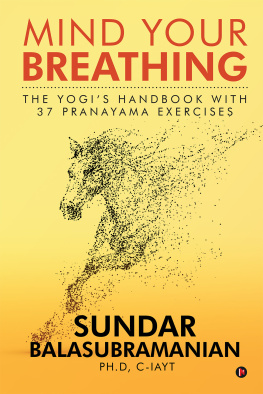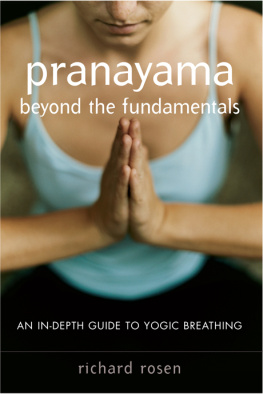Pranayama:
15 Step-by-Step Breathing Techniques to Relieve Stress and Calm Your Mind
Disclaimer: All photos used in this book, including the cover photo were made available under a Attribution-Non Commercial-Share Alike 2.0 Generic and sourced from Flickr
Table of content:
Introduction: What is Pranayama?
Pranayama is a Sanskrit word, with pran meaning breath, and ayama meaning control. Breath controlsounds simple enough right? Just learning to control our breathing. But many of us have a much harder time with our respiration that we may realize. We rush from place to place, huffing and puffing, wheezing and panting. And as out of breath as we are, it often sends our entire body off-balance. You see, the quality of our breathing is much more important than we would care to admit.
Pranayama approaches the common practice of breathing as it were an artform, utilizing many centuries of respiratory perfection. For much of this time, the art of breathingas it werewas mostly confined to monasteries in India, it wasnt until much more recently that this practice became known to the wider world. Pranayama was actually intensely guarded in mystical circles as a secret art, with most Yogis (practitioners of Yoga) extremely reluctant to share their closely held secrets.
Usually, only the initiated who had proved themselves by passing several trials and tests were invited to learn more about pranayama. Previously it was only after a would-be adherent to pranayama subjected themselves to much fasting, and perhaps a few climbs of the Himalayan mountains with heavy rocks strapped to their backs, that these Yogic Masters shared their hidden knowledge. But you no longer have to climb Mt. Himalaya with a backpack full of rocks in order to train yourself in pranayama, the doors of knowledge have now been opened wide for anyone willing to venture in.
Chapter 1: Preparing for Pranayama
Before we begin our breathing exercises, there are a few things that you should prepare for in advance. You need to make sure that you are in the right place, and utilizing the right time, to make sure that your routine isnt interrupted, and that you get the most benefit from its practice. You also need to make sure that you are physically prepped with the right diet and sufficient rest so that you can be in the best condition to engage in a pranayama routine. Here in this chapter we will make sure that you learn the best way to prepare and optimize yourself for your pranayama breathing exercises.
Creating the Ideal Atmosphere for Pranayama

The Yogis of old have spoken at great length when it comes to the ideal atmosphere in which pranayama should be practiced. Some of the recommendations that these ancient Indians crafted are largely irrelevant to us today, but other pieces of advice still hold true. Take this piece of ancient wisdom for example, the Yogis always instructed followers of pranayama, that they should practice their breathing exercises, in a province with a stable government, ruled by a kind, religiously minded ruler, stable government, ruled by a kind, religiously minded ruler and inhabited by religious masses.
For most in North America and Europe, such instructions are thankfully devoid of meaning, but in the ancient world where many regions were subject to invasion, ruthless dictatorships, and generally chaotic governments, such things had to be sorted out! Another piece of advice given about proper atmosphere is in much the same vein, stating, that there should be, no fear of invasion and no disturbance from beasts, thieves, bad characters, insects, epidemics, and natural calamities like draught or floods.
This is again, a no brainer for most of us, and is basically stating, Only do Pranayama in places where you wont get killed! If you are planning on meditating in a back alley of the Bronx in New York, at 3 in the morning, its probably not a good idea. I think we can all understand that. But besides basic precautions for physical safety while engaging in Pranayama, what can we do? Number one, find a quite place. That means absolutely quiet, no TV, no radio, no conversations in the background.
You need to be in an environment where you can primarily focus on your breathing and not on other sounds reverberating around you. If your own living environment is unable to generate this kind of serenity, quiet corners of nature parks are a good place to practice, and so are private rooms in public libraries. But wherever you may go, just make sure that it is the ideal environment for pranayama.
Having Correct Posture and Seating

Next to creating the right atmosphere, the most important thing for any given breathing exercise is to have the right posture and seating while you perform it. You should make sure that the mind, as well as the joints, and muscles of the body are relaxed. If it helps you may want to engage in some brief stretching before you begin. Make sure you sit up straight, with your weight evenly balanced on your spine so that you can have the endurance to see your pranayama session through to the end.
Your body needs to be steady for prolonged meditative states, and pranayama is no different. If you are able, and it wont present any undue medical difficulties for youyou may also want to consider skipping breakfast as well. A full stomach tends to interrupt with the needed posture for pranayama. It is for this reason that it is often suggested to do pranayama early in the day before eating. Our lung capacity is also impacted by a full stomach, versus an empty one, so just keep all of these considerations in mind before you set out to do your breathing exercises.
Develop a Regular Pranayama Routine
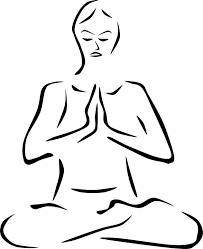
We all have routines. Even if its just waking up in the morning, making a pot of coffee, and going into the shower, we all have set habits and routines that engage in during our life. One of the most important things that you can do in your preparation for pranayama is to simply prep for your own regular routine for your breathing exercises as well. Because the truth is, the benefits of pranayama will never be fully realized if you only do it on rare occasions.
You need to have regular times in which you can complete your exercises. This means setting aside a specific time either every day, or at least a few times a week, in which you can engage in the same repetitive exercises without interruption and without hindrance. Some really enjoy the fact that they can have designated times in which to focus on this aspect of their life. It enables them to get away for an hour a day without having to feel guilty. And if anyone asks any questions, just say Hey! Give me a break folks! Its just a part of my regular pranayama routine!
Chapter 2: Practicing Abdominal and Diaphragm Breathing
Whether you actually practice the precepts of pranayama or not, it cant be stressed enough just how important abdominal breathing really is. The better we breathe out of our abdomen the better that we will generally feel. In pranayama, the breath that we breathe into ourselves is known as Shwas, and the breath that we breath out is known as Prashwas.
Using Pranayama Crocodile Breath

Next page

